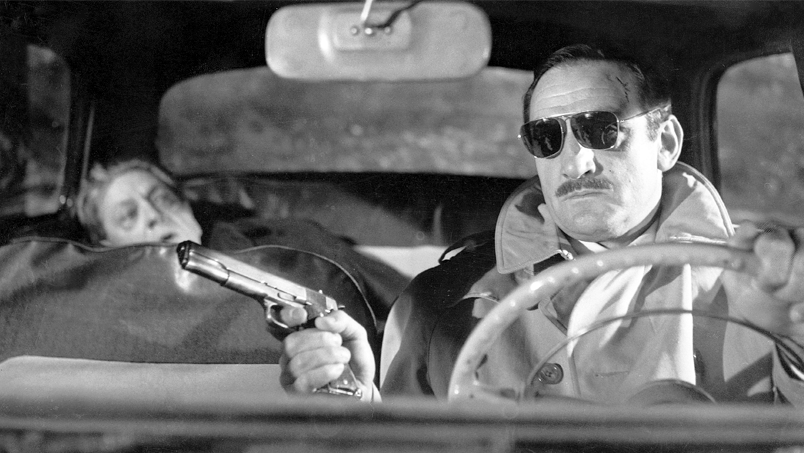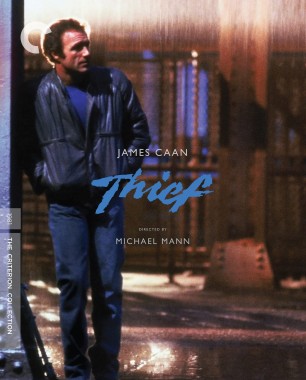The Devil in the Details

To make the performance of a tedious, exacting, time-consuming task riveting to watch, it is only necessary for the activity to be illegal. This is the lesson of heist movies, in which rigorous attention to process and stripped-down purity of focus are wedded to crowd-pleasing elements of suspense, violence, and hard-boiled patter. The caper film typically takes the audience step by step through the planning and execution of a crime that is at once a military-style campaign, a mechanical puzzle, a work of art, and a job. The crowning irony, and the link to film noir, is the way the three P’s of a successful heist—precision, patience, professionalism—are inevitably swamped by messy human failings: greed, distrust, panic, sloppiness, spite. As Doc Riedenschneider (Sam Jaffe), the genre’s aphoristic guru, sums it up in The Asphalt Jungle (1950): “One way or another, we all work for our vice.”
John Huston’s film brazenly ignored the Production Code’s warning against explicitly showing the methods of crimes. And while it seems unlikely that real-world crooks ever copped techniques from the movies, as censors apparently feared, a host of films indeed followed Huston’s blueprint closely. In an interview on Criterion’s release of The Asphalt Jungle, film historian Eddie Muller cites it as the first full-fledged heist movie, and lays out elements that formed a template for the genre: the assembly of a team of specialists, portrayed as matter-of-fact professionals more honorable than the upper-class amateurs who bankroll them, and above all the presentation of the robbery itself in detail, more or less in silence and in real time. (Muller, founder of the Film Noir Foundation, has programmed a twenty-four-film tour of “heists, hold-ups, and schemes gone awry” for the fifteenth Noir City festival in San Francisco, starting this Friday and ending on January 29. The series opens, naturally, with The Asphalt Jungle.)
Within familiar outlines, heist movies span a wide range, shading from glamorous cool (Bob le flambeur) to gritty social realism (Blue Collar), from comic spoofs (The Ladykillers, Big Deal on Madonna Street) to bleak futility (Plunder Road, The Friends of Eddie Coyle). And the formula translates across times and cultures, from the mid-twentieth century to the present, from France to Japan and Italy to Argentina. A caper often serves as the hook for a character study of a group or even a whole community—the postwar sunbelt suburb riddled with lurid secrets in Violent Saturday (1955); the grimy, broken-down, yet irrepressible New York of The Taking of Pelham One Two Three (1974). Daring heists are often conceived as revenge against the system by men who feel wronged (disgruntled cops or army officers in Kansas City Confidential, Odds Against Tomorrow, The League of Gentlemen). It’s easy to root for criminals who target jewelry stores, banks, casinos, or big businesses; easy to see them as plucky outsiders pitted against the faceless, crushing power of money itself.
Requiring teamwork, heists pull together groups of people who may have nothing in common except opportunism and avarice, and whose underlying antagonism ticks away like a time bomb threatening the whole enterprise. There is no more mismatched set of misfits than the ensemble in Stanley Kubrick’s The Killing (1956), which looks at a racetrack holdup from a prismatic sequence of different angles, giving each of its unsavory participants the leisure to reveal his or her warped, tawdry raison d’être, in blackly funny dialogue by pulp master Jim Thompson. Women in heist movies usually figure as catalysts—the reason guys need all that dough—and sometimes as helpers or spoilers. In The Killing, noir’s caustic vision of the war between the sexes is pushed to its most grotesque extreme in the hellish marriage of George and Sherry Peattie, played by two icons (Elisha Cook Jr. and Marie Windsor) who fearlessly grope into noir’s darkest, coldest, and grubbiest corners. The delusion that a big score will transform a dreary existence was never more obviously a bitter joke.

But this dream, compounded of avarice and pure artistry, is the heart of the heist movie. Wealth—in the form of glittering gems, bars of gold, or fresh bales of greenbacks—lies at the center of a labyrinth, protected by locks, safes, alarms, and guards. To liberate it takes planning and scheming, tools and expertise. In Rififi (1955), made in France by blacklisted American director Jules Dassin, the robbery lasts thirty minutes without music or dialogue, a ballet of suspense and ingenuity that welds the viewer to the screen and to the fate of the somewhat feckless perpetrators. By the time we get to Michael Mann’s Thief (1981), dedication to process and magnification of detail reach the level of abstraction, with long, hypnotic close-up shots of drills biting through the metal layers of safes, throwing off cascades of sparks. With its synthesizer music and video-game-like environment of neon-washed alleys and greenish tunnels, Thief evokes an icily mechanized world. Even the loot, little white packets of uncut diamonds, seems sterile and inhuman. In the fluorescent glare of a diner, the titular safecracker Frank (James Caan) explains to his date (Tuesday Weld) that the only way to survive prison, where he spent many years, is to “get to where nothing means nothing.” His dream is a domestic idyll with a wife and kids, and to achieve it he succumbs against his better judgment to a deal with a Mephistophelian Mr. Big, but there is something frozen and nihilistic at the core of the film, which no arson fire or cutting torch can melt.

Prison, where Frank was mentored by a lifer (Willie Nelson), where Doc Riedenschneider plotted his flawless knockover, is always present in heist films as a shadow or mirror image: a box you try to break out of instead of into, a place they lock you up for busting locks. Jean-Pierre Melville’s Le deuxième souffle (1966) opens with three men escaping from jail, a wordless sequence that unfolds with elegant minimalist rigor: in this stark maze of planes and angles, timing and the measurement of distances are matters of life and death. Jailbreaks, like heists, depend on meticulous planning and patience and teamwork. Films like Bresson’s A Man Escaped (1956) and Becker’s Le trou (1960) have the same austere focus on men digging holes, whittling away at door panels, or braiding ropes, that caper movies devote to men drilling locks and defusing alarms.
In Melville’s film, one of the escapees (Lino Ventura) later joins three other men in robbing an armored truck. In the dry hills high above Marseille they wait silently for their quarry, as the sun beats down on the rocks and a bank of fog rolls over the sea. They study ants crawling in the dirt, and moments later the armored truck with two motorcycle cops comes into view, tiny in the distance, creeping along winding roads. In a sudden, jolting rush they leap into action; their crisp efficiency is exhilarating, but it’s clear that the cops they shoot mean no more to them than ants. A little rain starts to spit as they unload platinum bars from the truck; once the loot is hidden and everything squared away Ventura catches a train from a drizzly provincial station, slipping back into a life so ordinary as to be invisible.

Le deuxième souffle and Le trou were both based on the writing of José Giovanni, who had done time on death row in France. There he got to know the collaborationist gangster Abel Danos, who inspired the protagonist of another Giovanni screenplay, for Claude Sautet’s Classe tous risques (1960). Again played by Lino Ventura, the film’s Abel Davos is a French gangster on the lam in Italy, who attempts to return to France with his wife and two young sons. In the film’s opening moments, after a mutedly tender parting from his family, he and a buddy stroll through the crowded streets of Milan, then suddenly clobber two bank guards, grab a satchel of money, and flee. Much later, Abel holds up a nervous, oily fence (Marcel Dalio) when he needs cash. Aside from these two quick and dirty crimes, he spends the entire film either running or hiding—in the back of an ambulance or in a small maid’s room at the top of a shabby building. Like Le deuxième souffle, this is a story about a man in decline, about the attrition of loved ones, of trust, of hope. Despite obvious similarities, the two films are ultimately very different. Melville’s later work is cool, terse, stylishly formal. Its aging antihero is still a tough, ruthless force; he cares more about his reputation, his code of conduct, than about his life. Classe tous risques, one of the saddest and most unglamorous of all gangster movies, is not about abstract notions of honor and loyalty but about real friendships and family ties. By the end, realizing that his life outside the law has destroyed everyone he cares about, Abel stops caring about anything—he gets to where “nothing means nothing.”
Heist movies commonly end with a sense of waste, the failure of a great project, passionate and painstaking effort scattered to the winds. Here too The Asphalt Jungle established the archetype, with its almost-clockwork crime devolving into stupid accidents, violence, double crosses, and self-destructive compulsions. Like the dream of one final job before going straight, honor among thieves is a persistent illusion. The perfect crime is a fantasy, crafted and clung to by men as they grind out the hours and years in their cells. The devil, and the beauty, is in the details.












